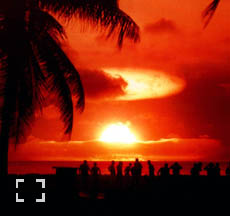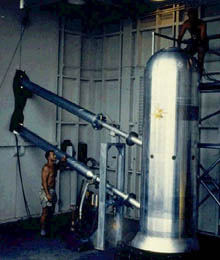 |
|
Operation Redwing - 1956

Mohawk - 02/07/1956
|
Operation Redwing, conducted at both Enewetak and Bikini atolls, was a 17 shot testing series testing thermonuclear devices too large to test at the Nevada Test Site. Redwing was an open series, meaning members of the media and press were allowed to observe the shots. This was the first time an open series had been held at the Pacific since Operation Crossroads in 1946. Redwing’s purpose was primarily for weapons development, however, weapons effects tests had been carried out mainly during the Cherokee event. Smaller and lighter devices were tested, sometimes at the expense of efficiency.
Operation Castles total yield output was 48 megatons, more then double the amount predicted. Due to the large amount of radioactive products released by Operation Castle in 1954, Redwing was put on a yield budget. The maximum allowable yield for the 17 shots was 20 megatons. The actual total yield of Redwing was 20.82 megatons, 6-10 megatons of that came from fission, less than Castle Bravos fission output.
Redwing proof tested the Mk-28 warhead and the first three-stage thermonuclear device. Most of the devices tested during Redwing were scaled down 'clean' versions. However, some 'dirty' ones were also tested, such as Flathead (June 12, 1956) and Tewa (July 21, 1956). Some very small tactical nuclear warheads were also tested during Redwing. Some devices had diameters as small as 13 cm. Devices from both the Los Alamos and UCRL laboratories were tested, often with much dispute about the sharing of the energy budget put on Redwing.
Testing was organized and conducted by Joint Task Force 7 (JTF 7), a combined military and civilian operation. Military personnel, Federal civilian employees, and contractor personal from the Department of Defense and Atomic Energy Commission made up JTF 7. In addition, several thousand from the AEC, few from other government agencies, and foreign observers were present. The test names are all American Indian tribes. The UCRL devices were names for birds and musical instruments.
Numerous technical experiments were carried out in conjunction with each of the 17 shots. These experiments measured the yield and efficiency of each shot, as well as gauged military effects of the explosions. Most of the Navy support group was located at Bikini, where its ships served as living space during evacuations of the atolls. The majority of the tests were conducted either twenty or fourty minutes before sunrise, as at this time the atmosphere was more likely to be cloud free.
During shot Mohawk a gamma ray diagnostic experiment utilized a massive shield near shot the tower. The shield consisted of 15cm of lead, and 30cm of paraffin on the device side to hold back neutrons. Paraffin being a neutron absorbing material due of its high hydrogen content. This shield caused a pimple to form on the initial fireball.

Tewa device |Bassoon Prime|
|
Animal testing was conducted during shots Lacrosse, Erir. Mohawk, Cherokee, Zuni and Navajo to study chorioretinal burns as the result of viewing the fireball. Rabbits and monkeys were exposed in holding devices so their eyes looked at the burst point.
Testing was also conducted concerned with checking the effect of multimegaton devices on buildings. Six steel-frame, industrial-type buildings constructed on Iroij and three manmade islands were instrumented and exposed to the positive phase of the Cherokee blast.
One minute before shot time, personnel with high-density goggles were instructed to put them on. Goggles were not to be removed until at least 10 seconds after the initial blast, and then only gradually, to accommodate the light change. Those without goggles were to face away from zero point, shield their eyes, and not view the fireball until at least 10 seconds after the burst. Personnel were instructed not to look at the fireball with binoculars at any time and were warned that sunglasses were not to be used in lieu of high-density goggles, as they would afford no protection against the light Of the fireball.
The highlight of Redwing was the Cherokee event. Cherokee was the first U.S. air drop of a thermonuclear weapon. This was a response to the Soviet Union’s successful air drop of a two-stage thermonuclear weapon in 1955. Weapons Effects studies during Redwing were centered on Cherokee but many failed due to a bombing error by the B-52 that dropped the bomb. The intended ground zero was directly over Namu Island, but the flight crew mistook an observation facility on a different island for their target. The bomb detonated some 6.5 km off target over the ocean northeast of Namu.
|
- Click on a thumbnail for a larger version
|
Test Shots
| Video |
Name |
Yield |
Date |UTC| |
Type |
Warhead |
Location |
LAT/LONG |
 |
Lacrosse |
40 Kt |
18:20 04/05/1956 |
Surface @5m |
TX-39 |
Off Runit Isl.- Enewetak |
11.55780 162.35500 |
 |
Cherokee |
3.8 Mt |
17:50 20/05/1956 |
Airdrop @1325m |
TX-15/39 |
Off Namu Isl.- Bikini |
11.66830 165.39420 |
 |
Zuni |
3.5 Mt |
17:56 27/05/1956 |
Surface @3m |
TX-41 |
Eninman Isl.- Bikini |
11.49670 165.36920 |
 |
Yuma |
0.19 Kt |
19:56 27/05/1956 |
Tower @60m |
- |
Aomon Isl.- Enewetak |
11.62000 162.33000 |
 |
Erie |
14.9 Kt |
18:15 30/05/1956 |
Tower @90m |
TX-28c |
Runit Isl.- Enewetak |
11.54440 162.36440 |
 |
Seminole |
13.7 Kt |
00:55 06/06/1956 |
Surface @2m |
TX-28 |
Bogon Isl.- Enewetak |
11.67640 162.22220 |
 |
Flathead |
365 Kt |
18:26 11/06/1956 |
Barge @4.5m |
|
Off Yurochi Isl.- Bikini |
11.60000 165.45140 |
| - |
Blackfoot |
8 Kt |
18:26 11/06/1956 |
Tower @60m |
- |
Runit Isl.- Enewetak |
11.55110 162.35860 |
| - |
Kickapoo |
1.49 Kt |
23:26 13/06/1956 |
Tower @90m |
- |
Aomon Isl.- Enewetak |
37.13860 -116.11780 |
 |
Osage |
1.7 Kt |
01:14 16/06/1956 |
Airdrop @210m |
XW-25 |
Runit Isl.- Enewetak |
11.62000 162.33000 |
| - |
Inca |
15.2 Kt |
21:26 21/06/1956 |
Tower @60m |
XW-45 |
Rujoru Isl.- Enewetak |
11.63000 162.35000 |
 |
Dakota |
1.1 Mt |
18:06 25/06/1956 |
Barge |
TX-28c |
Off Yurochi Isl.-Enewetak |
11.60280 165.45140 |
 |
Mohawk |
360 Kt |
11:55 02/07/1956 |
Tower @90m |
- |
Eberiru Isl.- Enewetak |
37.13860 -116.11780 |
 |
Apache |
1.85 Mt |
18:06 08/07/1956 |
Barge |
XW-27 |
Ivy Mike crater-Enewetak |
11.67140 162.20030 |
 |
Navajo |
4.5 Mt |
17:56 10/07/1952 |
Barge |
TX-21c |
Off Yurochi Isl.-Bikini |
11.66330 165.38720 |
 |
Tewa |
5 Mt |
17:46 20/07/1956 |
Barge |
TX-41 |
Off Namu/Yurochi Isl.-Bikini |
11.67390 165.33940 |
 |
Huron |
250 Kt |
18:12 20/07/1956 |
Barge |
XW-50 |
Off Flora Isl.- Enewetak |
11.67190 162.36920 |

| - DNA 6037F - Defense Nuclear Agency report - Redwing
|
|
|
|
 |





